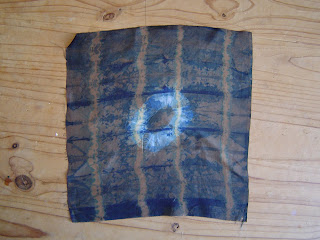The samples below show cotton voile dyed with natural Indigo dye using the Shibori technique and various resists. These are from top left clockwise:
- tying small sections of fabric with rubber bands to achieve random circles;
- folding the fabric and tying wood blocks over a large area to achieve large blocks of colour;
- folding in narrow folds and clamping with bull dog clips; and
- folding in narrow folds and placing rubber bands at various intervals down the length of fabric.
Below: Silk habutae dyed with Indigo and natural dyes. Some samples were overdyed using different resists for each dye bath. Natural dyes used were: Australian Eucalypt leaves, Cootamundra wattle leaves and the leaf of another wattle species. Mordants used were: Alum with wattle (soft yellow colour); copper with one wattle species and iron with the eucalypt leaves. This produced soft yellow to dark brown/black effects. Indigo overdyed with natural dye using Eucalyptus produced a rich yet subtle dark brown colour.
 |
Below: Silk habutae and twill were dyed with Indigo dye in the Shibori technique using clamping, sewing and tying as resists. One piece tied small sections of fabric over buttons of different sizes (No 3). This resulted in some interesting efffects where the image of the button was transferred to the surface of the silk.











1 comment:
patterned fabric :Explore our big selection of fabric, Chantilly lace, buy cotton, patterned fabric, buy silk and chiffon. We are best Online Fabric Store in Dubai buy silk & patterned fabric.
Post a Comment